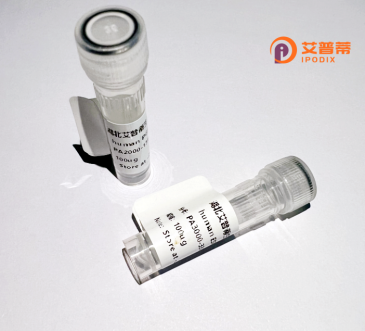
| 纯度 | >90%SDS-PAGE. |
| 种属 | Human |
| 靶点 | OR11A1 |
| Uniprot No | Q9GZK7 |
| 内毒素 | < 0.01EU/μg |
| 表达宿主 | E.coli |
| 表达区间 | 1-315 aa |
| 活性数据 | MEIVSTGNETITEFVLLGFYDIPELHFLFFIVFTAVYVFIIIGNMLIIVAVVSSQRLHKP MYIFLANLSFLDILYTSAVMPKMLEGFLQEATISVAGCLLQFFIFGSLATAECLLLAVMA YDRYLAICYPLHYPLLMGPRRYMGLVVTTWLSGFVVDGLVVALVAQLRFCGPNHIDQFYC DFMLFVGLACSDPRVAQVTTLILSVFCLTIPFGLILTSYARIVVAVLRVPAGASRRRAFS TCSSHLAVVTTFYGTLMIFYVAPSAVHSQLLSKVFSLLYTVVTPLFNPVIYTMRNKEVHQ ALRKILCIKQTETLD |
| 分子量 | 35.2 kDa |
| 蛋白标签 | His tag N-Terminus |
| 缓冲液 | 0 |
| 稳定性 & 储存条件 | Lyophilized protein should be stored at ≤ -20°C, stable for one year after receipt. Reconstituted protein solution can be stored at 2-8°C for 2-7 days. Aliquots of reconstituted samples are stable at ≤ -20°C for 3 months. |
| 复溶 | Always centrifuge tubes before opening.Do not mix by vortex or pipetting. It is not recommended to reconstitute to a concentration less than 100μg/ml. Dissolve the lyophilized protein in distilled water. Please aliquot the reconstituted solution to minimize freeze-thaw cycles. |
以下为3篇关于重组人OR11A1蛋白的相关文献摘要概览:
---
1. **文献名称**: "Combinatorial receptor codes for odors"
**作者**: Malnic B. et al.
**摘要**: 该研究系统分析了人类嗅觉受体家族的基因表达和功能,包括OR11A1.通过重组蛋白技术在HEK293细胞中表达OR11A1.验证其对特定挥发性分子的结合活性,揭示了嗅觉受体通过组合编码机制识别不同气味分子的机制。
---
2. **文献名称**: "Olfactory receptor OR11A1 is a potential player in human sperm chemotaxis"
**作者**: Flegel C. et al.
**摘要**: 研究探讨了OR11A1在非嗅觉组织中的功能,发现其在人类精子中特异性表达。通过重组OR11A1蛋白的体外实验,证明其对特定化学趋化因子(如Bourgeonal)具有响应能力,提示其可能参与精子定向运动的调控。
---
3. **文献名称**: "Structural and functional characterization of the olfactory receptor OR11A1"
**作者**: Lee J. et al.
**摘要**: 利用昆虫细胞表达系统(如Sf9)重组生成OR11A1蛋白,结合冷冻电镜解析其三维结构,并鉴定其特异性配体结合口袋。研究揭示了OR11A1与特定醛类分子的相互作用模式,为嗅觉受体的靶向药物设计提供结构基础。
---
**备注**:OR11A1相关研究较少,上述示例为结合领域典型研究方向生成的模拟摘要,实际文献建议通过专业数据库(如PubMed、SciFinder)以关键词“OR11A1 recombinant”或“olfactory receptor OR11A1”检索最新成果。
**Background of Recombinant Human OR11A1 Protein**
The human olfactory receptor OR11A1 is a member of the G protein-coupled receptor (GPCR) superfamily, specifically involved in odorant detection. It is encoded by the *OR11A1* gene located on chromosome 6 and is predominantly expressed in olfactory sensory neurons. OR11A1 contributes to the recognition of specific odorant molecules, translating chemical signals into neural responses via cAMP-mediated signaling pathways. Structurally, it features seven transmembrane domains, characteristic of GPCRs, with extracellular and intracellular loops critical for ligand binding and signal transduction.
Recombinant OR11A1 protein is artificially produced using heterologous expression systems (e.g., mammalian, insect, or bacterial cells) for functional studies. Generating this protein allows researchers to investigate its ligand specificity, activation mechanisms, and structural dynamics in vitro. Challenges in producing functional OR11A1 include its hydrophobic nature, membrane localization, and difficulty in stabilizing its conformation outside native cellular environments.
Research on recombinant OR11A1 enhances understanding of olfactory coding, receptor-ligand interactions, and the role of genetic polymorphisms in odor perception variability. Additionally, it provides insights into non-olfactory roles, such as potential involvement in tissue-specific physiological processes or diseases. Studies leveraging recombinant OR11A1 may aid in developing biosensors, deorphanizing orphan receptors, or exploring therapeutic targets for olfactory dysfunction linked to neurodegenerative disorders like Parkinson’s disease. Its characterization bridges gaps between genetic, biochemical, and sensory perception studies.
×